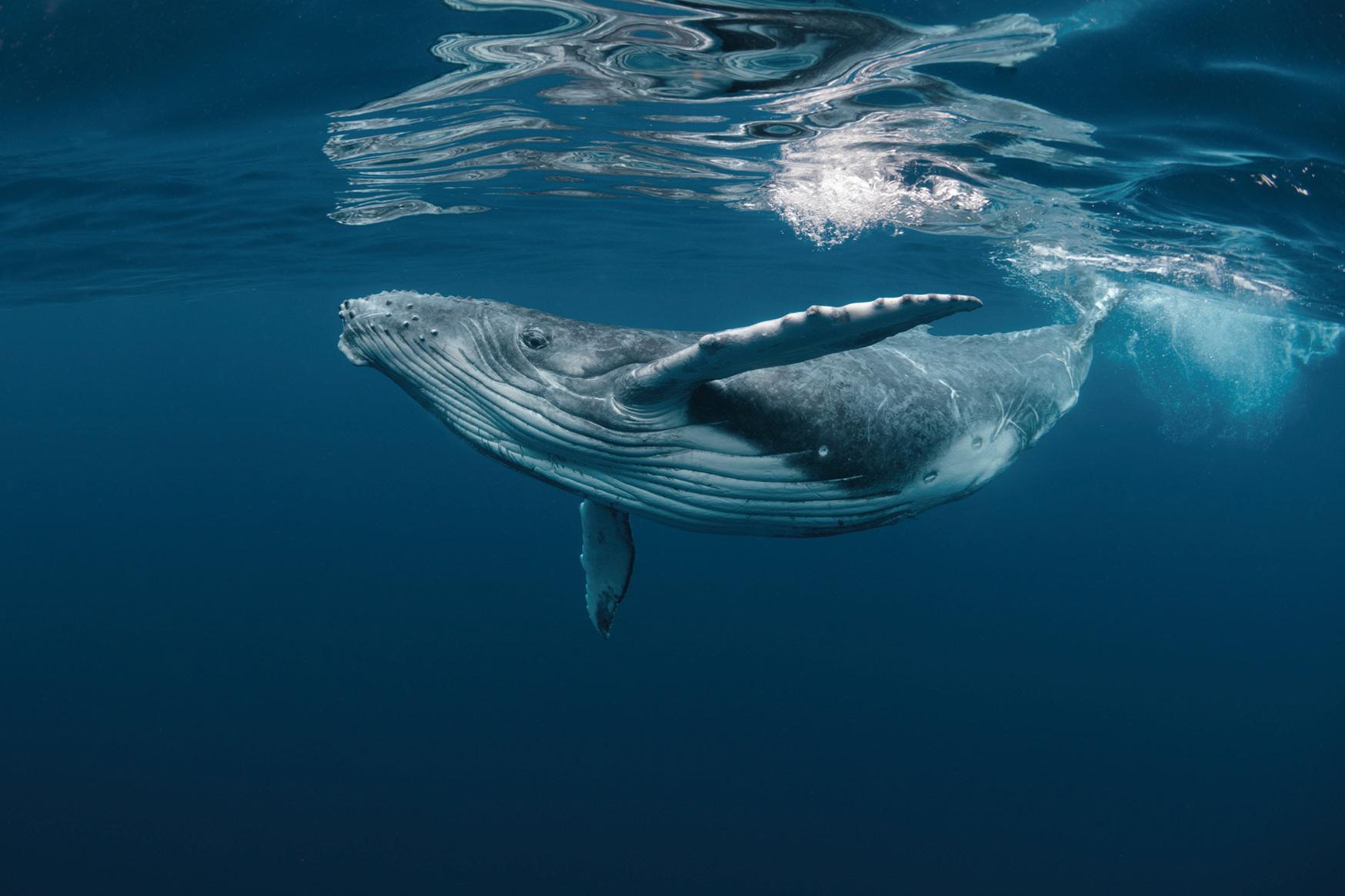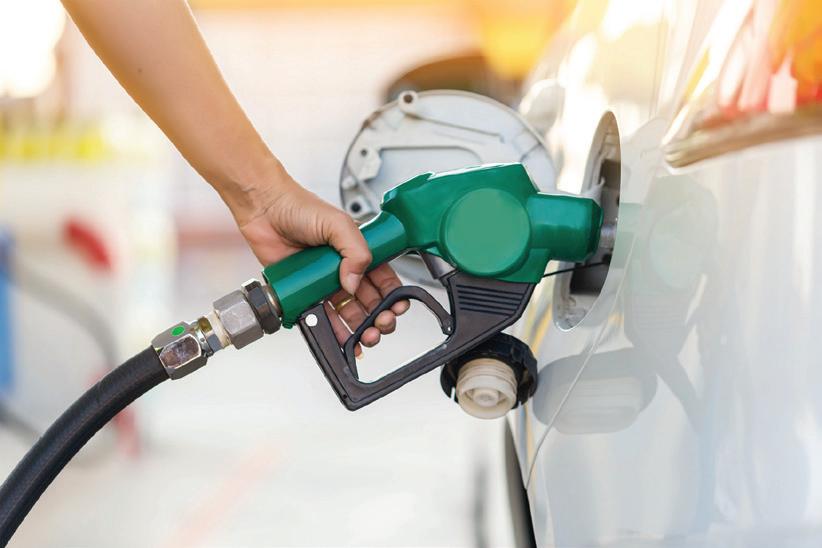BIOLOGY

Sample chapter
This sample chapter is provided in draft format for inspection purposes.
To learn more about the print and digital resources that support the series, visit: oup.com.au/qldbio.



Sample chapter
This sample chapter is provided in draft format for inspection purposes.
To learn more about the print and digital resources that support the series, visit: oup.com.au/qldbio.

All organisms require energy to drive the chemical reactions necessary for their survival. Metabolism is the total sum of chemical reactions that occur inside cells, to help the cells survive. There are two types of metabolic reactions: catabolic reactions, which produce energy, and anabolic reactions, which require energy. Cellular respiration is a key catabolic reaction that occurs in all living things. In cellular respiration, glucose is broken down, producing chemical energy in the form of ATP. This process is more efficient when it occurs in the presence of oxygen. When it occurs in the absence of oxygen, unwanted chemicals are produced.
→ Distinguish between catabolism and anabolism.
→ Explain how ATP allows energy from catabolic reactions to be used in anabolic reactions.
→ Describe the process of aerobic respiration, identifying the location in the cell and net inputs and outputs of
→ glycolysis
→ Krebs cycle and electron transfer chain
→ the overall reaction (C6 H12O6 + 6O2 → 6CO2 + 6H 2O + 36–38 ATP).
→ Compare aerobic and anaerobic respiration.
→ Appreciate that scientists can use their understanding of natural systems to develop new technologies.
Source: Biology 2025 v1.0 General Senior Syllabus © State of Queensland (QCAA) 2025
Check your understanding of cellular reactions before you start. If you need to revise, you’ll be assigned a helpful resource.

Exclusively on Oxford digital.
Learning intentions and success criteria
energy the capacity to do work
kinetic energy the energy of motion
potential energy stored energy
chemosynthesis
the process in which reactions of inorganic substances are used to provide energy for the synthesis of organic compounds
photosynthesis the process in which light energy is converted to the chemical energy of glucose; requires chlorophyll, carbon dioxide, water and a suitable temperature; occurs in green plants, algae and some bacteria
→ Energy is the ability to do work or to cause a change.
→ Metabolism is all the chemical reactions that take place inside a cell or an organism.
→ There are two types of metabolic reactions. In anabolic reactions, new larger molecules are synthesised and energy is consumed. In catabolic reactions, large molecules are broken down, releasing energy.
Energy is the ability to do work or to cause a change. Energy is required for all the chemical reactions that occur within cells. All cells need a constant supply of energy to grow, reproduce and stay alive. Cells mostly use chemical energy, and many organisms obtain chemical energy from their food. For some types of cells, light is an important source of energy. There are two main types of energy: kinetic energy (the energy of motion) and potential energy (energy that is stored).
The compounds that make up living cells are highly complex. Some are composed of thousands of atoms bonded together. Many of these bonds, particularly carbon-tohydrogen or “C–H” bonds, have relatively large amounts of chemical energy stored within them. This means that each living organism has a “storehouse” of potential chemical energy that can be harnessed when necessary to do work. Each time this stored energy is converted to other forms for use, less energy remains in reserve. Therefore, each organism needs an external source of energy that can be used to replenish its supply of chemical-bond energy. For organisms that cannot create their own food (heterotrophs), this outside energy source is other organisms. For organisms that can produce their own food (autotrophs), the source may be inorganic molecules (chemosynthesis) or sunlight ( photosynthesis).


Metabolism is all the chemical reactions that take place inside a cell or an organism. Metabolic processes proceed in small steps, the sum of which is called a metabolic pathway. There are two types of metabolic reactions.
• Anabolism describes the reactions that synthesise new larger molecules. Anabolic reactions tend to absorb energy (endergonic), as energy is used to form new bonds.
• Catabolism describes the reactions that break down large molecules into smaller ones. Catabolic reactions tend to release energy (exergonic), as bonds are broken between atoms.
All the catabolic and anabolic reactions occurring at any time in a cell constitute its metabolism.
anabolism + catabolism = metabolism
The energy released in catabolic reactions is used to drive anabolic reactions, for work (e.g. muscular contractions) and for maintenance. Some energy is lost as heat energy.
Anabolism
Metabolic pathway
Metabolic pathway simple molecules + energy
2 Anabolic and catabolic reaction pathways
Catabolism
complex molecules
To remember the difference between anabolism and catabolism, think of “ABCD”: anabolism builds, catabolism destroys.
metabolism all the chemical reactions occurring within a cell
anabolism
chemical reactions in which large molecules are built up, usually with a net input of energy
endergonic describes a chemical reaction involving the absorption of energy
catabolism
chemical reactions in which large molecules are broken down into smaller ones, usually with the release of energy
One of the most important metabolic pathways yielding energy is the breaking down of sugar. This is an oxidation process. As sugar is broken down, energy is released and carbon dioxide and water are formed. The process, called cellular respiration, can be shown in simplified form by the following:
The sugar molecule, C6 H12O6 or glucose, contains potential energy, which is freed only when the bonds holding the atoms in the molecule together are broken and new, lower-energy molecules are formed. Anabolic reaction
molecules
reaction
FIGURE 3 Visual summary of anabolic and catabolic reactions
molecules
molecule
exergonic describes a chemical reaction in which energy is released
Check your learning 7.1
Check your learning 7.1: Complete these questions online or in your workbook.
Retrieval and comprehension
1 Define metabolism. (1 mark)
2 E xplain why cells require a constant input of energy. (1 mark)
3 Explain what happens to energy when a chemical bond is broken and when a chemical bond is formed. (2 marks)
Analytical processes
4 D istinguish between anabolism and catabolism. (2 marks)
5 Classify each of following reactions as anabolic or catabolic. Justify your answer.
a 6CO2 + 6H 2O + sunlight → C6H12O6 + 6O2 (2 marks)
b C6H12O6 + 6O2 → 6CO2 + 6H 2O + energy (2 marks)
→ Adenosine triphosphate (ATP) is an important molecule in living organisms. In ATP, energy is stored in a readily available form and can be transferred from one site to another.
→ An ATP molecule consists of the nitrogen base adenine, a ribose sugar and three phosphate groups arranged in sequence.
→ When ATP loses a phosphate, it becomes adenosine diphosphate (ADP). Energy is released by the breaking of the high-energy bond.
Learning intentions and success criteria
adenosine triphosphate (ATP)
an organic chemical able to store and release large amounts of energy; consists of the nitrogen base adenine bound to three phosphate groups
Energy released at one site of a cell is often required at another site. This is important in all metabolic reactions. In biological systems, some molecules are used to transport energy molecules from place to place, or simply to store energy in a readily accessible form.
Adenosine triphosphate (ATP) is the major molecule involved in this process. ATP is in all living things.
An ATP molecule is composed of an adenine unit, a ribose (five-carbon sugar) and three phosphate groups in sequence (Figure 1).
1 An ATP molecule consists of an adenine base (blue), a ribose sugar (pink) and a chain of three phosphate groups.
The bonds between the phosphate groups are high-energy bonds, often represented by the symbol “ ~ ”. These high-energy phosphate bonds are weak and unstable, and therefore can be readily broken. Usually, it is the phosphate bond furthest from the adenine that is broken to provide energy for metabolic reactions. The breaking of this phosphate bond produces a lower-energy, more stable compound called adenosine diphosphate (ADP). ADP consists of an adenine base, a ribose sugar and only two phosphate groups. The conversion of ATP to ADP releases a phosphate group and energy (Figure 2).
FIGURE 2 When an ATP molecule is broken down into ADP, one phosphate is removed and energy is released.
When a phosphate bond is broken in this reaction, the energy stored within the bond is released. This energy can then be used to fuel other metabolic reactions. The detached phosphate molecule will often attach to other molecules, in a reaction called phosphorylation. New ATP can be synthesised from ADP and a phosphate if there is enough energy available to bind a third phosphate group to the ADP.
The phosphate-bond energy of ATP is used to do cellular work. Metabolism therefore involves enzymes and the transfer of energy. Figure 3 summarises these reactions.
Anabolic reactions in cells build complex molecules from simpler molecules. These reactions usually involve specific enzymes and use energy.
Catabolic reactions in cells break down complex molecules into simpler molecules. These reactions usually involve specific enzymes and release energy.
A substrate is a substance acted upon by enzymes. Products are substances produced in chemical reactions.
FIGURE 3 The relationship between metabolism, enzymes and energy. These diagrams represent very simple metabolic pathways.
adenosine diphosphate (ADP) the nitrogen base adenine bound to two phosphate groups, each bond requiring an input of energy phosphorylation the addition of a phosphate group to a molecule; can be noncyclic (e.g. formation of ATP) or cyclic (e.g. the cyclic flow of electrons along the electron transfer chain from chlorophyll, the released energy being used in the formation of ATP)
Other organic carrier molecules are also important in energy transfer in metabolic pathways.
• NAD+ (nicotinamide adenine dinucleotide) receives electrons from other molecules and reacts with hydrogen ions to form NADH, which donates electrons for other reactions.
• FAD (flavin adenine dinucleotide) reacts with electrons and hydrogen ions in a similar way, to form FADH 2 .
It takes energy for the hydrogen ions and electrons to bond with the carrier molecules. Therefore, when the hydrogen ions are released from the carrier molecule, energy is also released. The NADH and FADH 2 molecules are important in the carriage of hydrogen in metabolic pathways.
Check your learning 7.2
Check your learning 7.2: Complete these questions online or in your workbook.
Retrieval and comprehension
1 Describe the features of the ATP molecule that enable it to function as an energy carrier in biological systems. (2 marks)
2 Explain how ATP provides energy for metabolic reactions. (2 marks)
Learning intentions and success criteria
cellular respiration the breaking down of glucose in cells to release energy; may occur with oxygen (aerobic) or without oxygen (anaerobic)
Analytical processes
3 C ompare ATP and ADP. (3 marks)
4 D istinguish between a metabolic reaction and a metabolic pathway. Suggest a reason for the occurrence of metabolic pathways. (3 marks)
→ Cellular respiration is a process in which glucose is changed into a usable form of energy. It can be summarised by the reaction: C6H12O6 + 6O2 → 6CO2 + 6H2O + 36–38 ATP.
→ Aerobic cellular respiration takes place in the presence of oxygen. It has three stages: glycolysis, the Krebs cycle and the electron transfer chain.
→ Glycolysis occurs in the cytoplasm. All other stages of aerobic respiration take place in the mitochondria.
Some autotrophs, such as plants and some bacteria, convert light energy into chemical energy in the form of glucose, through photosynthesis. Heterotrophs, such as humans and other animals, need to consume other organisms to acquire chemical energy in the form of glucose. All cells, whether heterotrophic or autotrophic, must convert glucose (C6 H12O6 ) into the energy ‘currency’ molecule, ATP.
Cellular respiration is the process in which glucose is converted into a usable form of energy. All cells, including the cells of autotrophs, must carry out cellular respiration to survive.
The process generally involves the oxidation of sugar in a series of small steps, each controlled by an enzyme. The energy released is stored in the ATP molecule for further use by the cell and can be transported to other cells or other sections of the cell within an organism.
Some steps in cellular respiration are endergonic (energy consuming), but most are exergonic (energy releasing). The overall reaction is exergonic and leads to the production of ATP. Each step in cellular respiration is controlled by a specific enzyme. Cellular respiration can occur two ways: aerobically (in the presence of oxygen) or anaerobically (in the absence of oxygen). In this lesson you will learn about aerobic respiration.
Cellular respiration begins with the breaking down of glucose into two molecules of pyruvate. Pyruvate and oxygen then enter the mitochondrion, where the pyruvate is broken down to release carbon dioxide, water and ATP molecules in the Krebs cycle and the electron transfer chain. Oxygen is needed to remove hydrogen released in the Krebs cycle, so that this cycle can continue.
The mitochondrion (plural “mitochondria”) is a double-membraned cell organelle. Its inner membrane is deeply folded, forming a series of cristae (shelves), which increase the surface area of this membrane. The whole structure is either spherical (e.g. in liver cells) or cigar-shaped, providing a high surface area-to-volume ratio for the efficient uptake and release of materials.
aerobically occurring in the presence of oxygen anaerobically occurring in the absence of oxygen
aerobic respiration the complete conversion of glucose to carbon dioxide and water in the mitochondria of cells with oxygen present, resulting in the release of a large amount of energy (net gain of 36 AT P)
glycolysis the first stage in cellular respiration; occurs in the cytoplasm and results in the gain of 2 AT P and 2 pyruvate molecules; does not require oxygen
acetyl-CoA a biomolecule involved in metabolism; the substrate that enters the Krebs cycle
1
mitochondrion:
The outer membrane controls the passage of materials into and out of the mitochondrion. The inner membrane contains the enzymes responsible for ATP production.
The matrix within the mitochondrion contains ribosomes, circular DNA molecules and the enzymes required for many of the steps in aerobic cellular respiration.
Aerobic cellular respiration has three stages:
1 glycolysis, followed by acetyl-CoA formation
2 the Krebs cycle
3 the electron transfer chain
Aerobic cellular respiration begins in the cytoplasm with glycolysis, a process in which a glucose molecule is broken down into two smaller molecules of a compound called pyruvate Glycolysis occurs in all living organisms. It is an anaerobic process – it does not require oxygen.
Krebs cycle
a cyclic series of chemical reactions in the mitochondria of cells: two acetyl-CoA molecules are converted to citric acid; with the addition of six water molecules, the citric acid releases six carbon dioxide molecules as waste and 16 hydrogen atoms; the hydrogen atoms are transferred to carrier molecules; two ATP are formed
electron transfer chain a series of coenzymes along which highenergy electrons pass, releasing energy to form ATP at each step in the chain; the final stage in aerobic cellular respiration in which most ATP molecules are formed pyruvate the product of glycolysis; used to synthesise many metabolic pathways
coenzyme A a coenzyme in biochemical reactions; reacts with pyruvate to form acetyl-CoA
It takes place in the cytoplasm of the cell, not the mitochondrion, because glucose molecules are too large to pass through the outer membrane of the mitochondrion. The glycolysis reaction is initiated when one glucose molecule reacts with two ATP molecules. The reaction (Figure 2) can be written as:
glucose + 2ATP + 2ADP + 2~P → 2 pyruvate + 4ATP
The glycolysis reaction results in:
• conversion of a six-carbon glucose molecule to two three-carbon pyruvate molecules
• formation of four ATP molecules, resulting in a net gain of two ATP molecules (four ATP molecules are produced, but two are initially needed as activation energy)
• formation of two hydrogen carriers (NADH).
TABLE 1 Summary of the location, inputs and outputs of glycolysis
Glycolysis Cytoplasm 2 AT P
Glucose (C6H12O6)
2 A DP
2 NAD+

2
If oxygen is present (aerobic respiration), the pyruvate molecules formed by glycolysis leave the cytoplasm and enter the mitochondrion by passing through the mitochondrion’s outer and inner membranes. Then, in the mitochondrial matrix, each pyruvate molecule reacts in the presence of a carrier molecule called coenzyme A . Pyruvate must be converted into acetyl-CoA before it can enter the Krebs cycle.
In this reaction (Figure 3), for each pyruvate molecule:
• a carbon dioxide molecule is released from the pyruvate as a waste product
• the two-carbon molecule that is left from the first step attaches to a coenzyme A molecule, forming acetyl-CoA and a hydrogen ion
• NAD+ gains two electrons and a hydrogen ion to form the hydrogen carrier NADH.
TABLE 2 Summary of the location, inputs and outputs of acetyl-CoA formation Process
The Krebs cycle is a series of chemical reactions in the mitochondrial matrix that start and finish with the same four-carbon molecules. Two acetyl-CoA molecules enter the cycle separately by combining with these four-carbon compounds to form two molecules of citric acid. Each step in the cycle is enzyme driven. For the cycle to proceed, it requires an input of six water molecules for each citric acid molecule, which releases:
• 16 hydrogen ions and electrons that are passed to hydrogen carriers (6 NA DH and 2 FA DH 2)
• another two ATP molecules
• four carbon dioxide molecules as a waste product
• a molecule that reacts with water to re-form the original four-carbon molecule.
Hydrogen carriers NADH Hydrogen ions and 6NADH Hydrogen ions and 2 FADH2
FIGURE 4 Glycolysis produces two three-carbon pyruvate molecules. If oxygen is present, the pyruvate moves into the mitochondria. Each pyruvate loses carbon dioxide and becomes acetyl-CoA. The acetyl-CoA then enters the Krebs cycle, resulting in the formation of carbon dioxide, ATP, and hydrogen ions and electrons on their hydrogen carriers.
TABLE 3 Summary of the location, inputs and outputs of the Krebs cycle
The inner membrane of the mitochondrion has many deep folds, known as cristae, to increase its surface area for the chemical reactions. A series of specialised enzymes associated with these reactions are embedded in this inner membrane. Hydrogen ions formed in the previous steps are released from their carriers to the electron transfer chain, along with high-energy electrons. At each step in the chain, energy is released from the electrons and used in the formation of ATP. At the end of the chain, the low-energy electrons combine with the hydrogen ions and, with an input of six oxygen molecules, form water. Overall, this step produces:
• 32 to 34 ATP molecules
• 12 water molecules, so there is a net of 6 molecules as a waste product. The overall equation for aerobic cellular respiration is often written as: glucose + 6 oxygen + 6 water + ADP + ~P → 6 carbon dioxide + 12 water + energy (ATP)
C6 H12O6 + 6O2 + 6H 2O + 36–38 ADP + 36–38~P → 6CO2 + 12H 2O + 36–38 AT P
It can be summarised as:
C6 H12O6 + 6O2 → 6CO2 + 6H 2O + 36–38 AT P
Depending on certain conditions, either 32 or 34 ATP molecules are produced during electron transfer chain reactions. There is a net gain of either 36 or 38 ATP molecules for every glucose molecule aerobically respired. For each glucose molecule, 6 CO2 and 6 H 2O are released (as waste), and 36 AT P molecules are released (as a chemical energy transfer molecule).

+ ½ O2
FIGURE 5 Enzymes embedded in the inner membrane of the mitochondrion carry electrons to the final electron acceptor, which produces ATP molecules.
TABLE 4 Summary of the location, inputs and outputs of the electron transfer chain
All laboratory experiments carry a level of risk. Each lab should have a folder of material safety data sheets (MSDS), which are often managed by a laboratory technician. Each MSDS contains information on a particular chemical, such as:
• chemical formula
• melting point
• boiling point
• alternative names
• handling and storage methods
• first aid support in case of exposure to the chemical
• disposal methods.
Before running any experiment, it is important to review the MSDS for the chemicals you will be using. You can then fill out a risk assessment.
1 The reactants and products of cellular respiration are listed in the table. Conduct an online search of MSDS and use the information in them to complete the table. (16 marks)
Danger to human health
Flammability
Boiling point
Melting point
Need help identifying and implementing strategies to manage risks? Go to Lesson 1.4 in your biology toolkit.
Check your learning 7.3: Complete these questions online or in your workbook.
Retrieval and comprehension
1 C onstruct a worded equation and a balanced chemical equation to describe aerobic cellular respiration. (2 marks)
2 Summarise aerobic cellular respiration by copying and completing the table. (16 marks)
Check your learning 7.3 Glycolysis
Location
Input(s)
Output(s)
Number of ATP formed
Learning intentions and success criteria
Practical
Lesson 7.4
3 E xplain why the folded inner membrane (cristae) of a mitochondrion is important for aerobic cellular respiration. (1 mark)
Analytical processes
4 Use the information in Question 2 to deduce which part of aerobic cellular respiration would be most affected by a lack of oxygen. (2 marks)
Learning intentions and success criteria
Key ideas
→ Anaerobic respiration occurs in the absence of oxygen.
→ There are two types of anaerobes: complete anaerobes, which respire using anaerobic respiration only, and partial anaerobes, which can switch between aerobic and anaerobic respiration depending on oxygen availability.
→ Anaerobic respiration in animals is facilitated through lactic acid fermentation.
→ Anaerobic respiration in plants, fungi and bacteria is facilitated through ethanol fermentation.
In all chemical pathways driven by enzymes, many factors can affect the rate of cellular respiration. The absence of oxygen is one such factor. Oxygen is required in the electron transfer chain; if oxygen is limited, this series of reactions cannot occur. This means that in the absence of oxygen, a cell will not be able to produce as much ATP. In such conditions, organisms produce ATP through anaerobic respiration.
In all organisms that respire, glycolysis occurs outside the mitochondria to break down glucose molecules into pyruvate and produce a net of two ATP molecules. If oxygen is present, respiration proceeds with the electron transfer chain to produce more ATP. However, oxygen is not always freely available. When this is the case, organisms generate additional ATP through anaerobic respiration. Some organisms can generate enough energy from anaerobic respiration alone. These organisms are known as anaerobes. In general, there are two types of anaerobes: complete anaerobes and partial anaerobes
Complete anaerobes live permanently in oxygen-deficient conditions and therefore only carry out anaerobic respiration. Some of these anaerobes (including certain bacteria and some parasites) may be poisoned by even low concentrations of oxygen.


Partial anaerobes thrive in the presence of oxygen but will resort to anaerobic respiration if oxygen is absent or in short supply. Examples of partial anaerobes are worms living in the mud at the bottom of stagnant pools or oceans and diving mammals such as whales that can stay under water for long periods. The length of time an organism can survive without oxygen varies. Humans can survive without oxygen for only minutes, whereas some simpler organisms and plants can respire anaerobically for much longer periods.
anaerobic respiration
cellular respiration in the absence of oxygen, resulting in a net gain of 2 ATP and lactic acid (in animals), or ethyl alcohol and carbon dioxide (in plants, fungi and bacteria)
complete anaerobe an organism that does not need oxygen for cellular respiration
partial anaerobe an organism that can undergo a period of anaerobic cellular respiration when oxygen is at low levels or in short supply
Fermentation is an anaerobic process in which glucose is broken down in the absence of oxygen. After pyruvate is formed by glycolysis, it enters one of two fermentation pathways, depending on the type of organism. In animals, lactic acid fermentation occurs, while in plants, fungi and bacteria, ethanol fermentation occurs. fermentation the anaerobic breaking down of sugar by bacteria and yeasts to form ethyl alcohol, carbon dioxide and two ATP
lactic acid fermentation a biological process in which glucose is converted into cellular energy, with lactate as a byproduct
ethanol fermentation a biological process in which glucose is converted into cellular energy, with ethanol and carbon dioxide as byproducts
Undergoes glycolysis (anaerobic process)
to produce two molecules of pyruvate, a 3-carbon compound.
If no oxygen is present, anaerobic respiration occurs.
Animals
Lactic acid in muscles is a product.
2 pyruvate produced Undergoes glycolysis Undergoes fermentation
2 lactate produced
myoglobin a protein in the muscles that can bind to oxygen
lactic acid an organic acid with the formula C 3H6O3 formed by the breaking down of glucose during anaerobic cellular respiration in animals oxygen debt the amount of oxygen required to convert the lactic acid produced during anaerobic respiration to pyruvate
If oxygen is present, pyruvate and oxygen move into the mitochondrion and aerobic cellular respiration produces carbon dioxide, water and energy
Plants + yeasts
Ethanol and carbon dioxide are products.
Anaerobic respiration in animals occurs through lactic acid fermentation. This can be represented by the following equation: glucose (C6 H12O6 ) → 2 lactic acid + 2ATP
As you learnt in Lesson 7.3, the glycolysis reaction produces two pyruvate molecules, two NADH and a net of two ATP molecules. When oxygen is not present, the two pyruvate molecules produced by glycolysis do not move into the mitochondria. Instead, they are converted into two lactate molecules in the cytoplasm of the cell.
When a person exercises vigorously, their body requires more energy than can be supplied aerobically. This is because their respiratory and circulatory systems cannot operate fast enough to sustain an adequate supply of oxygen. When oxygen levels in the blood begin to run low, oxygen is released from myoglobin, an oxygen-storing molecule in muscles. The levels of oxygen attached to the myoglobin are limited and eventually they become too low to sustain aerobic cellular respiration. The muscle fibres then provide energy anaerobically, producing lactate (which can become lactic acid). Like all acids, lactic acid is a metabolic poison and can cause damage if too much accumulates in the body. To prevent this, it is often rapidly transported to the liver, where it can be converted back into pyruvate and then glucose. Lactate that has been converted back to pyruvate can then re-enter the aerobic cellular respiration pathway if oxygen becomes available. The amount of oxygen needed to get rid of the lactic acid is called the oxygen debt . ‘Stiffness’ of muscles occurs when lactic acid accumulates and causes muscle fibre damage before it is broken down.

FIGURE 4 During vigorous exercise, lactic acid can build up in the muscles.
Anaerobic respiration in plants, fungi and bacteria occurs through ethanol fermentation. This can be represented by the equation:
glucose (C6 H12O6 ) → 2 ethanol ( C2 H 5OH) + 2CO2 + 2ATP
This process begins after glycolysis has occurred in the cytoplasm of the plant, fungal or bacterial cell that lacks oxygen. When oxygen is not present, the two pyruvate molecules produced stay in the cytoplasm and are converted into two acetaldehyde molecules and two carbon dioxide molecules. The acetaldehyde molecules are then converted into two ethanol molecules via NADH.
Because ethanol cannot be broken down by plants, a build-up of too much ethanol can be toxic to the organism. This means that, while plants can resort to anaerobic respiration for a short period (e.g. germinating seeds or roots in waterlogged soil), they must revert to aerobic respiration before ethanol levels reach toxic levels and cause death. Natural fermentation of yeasts (single-celled fungi) and bacteria has been used by humans for thousands of years.
During the breeding season of the “spring peeper” frog, Hyla crucifer, males let out a loud mating call to attract a female mate. Researchers studying male spring peepers have found that vocalising this call consumes large amounts of energy. When male spring peepers call, their concentration of lactic acid doubles compared to when they are in a resting state.
Undergoes glycolysis
Undergoes alcoholic fermentation
in plants, fungi and bacteria

1 Explain why a higher concentration of lactic acid builds up in spring peepers during a mating call. (1 mark)
Researchers have been developing biomolecules that enhance the performance and prolong the life of metal–air batteries, basing their design on cellular respiration. Metal–air batteries are still in development, but they have the potential to effectively replace petroleum-based fuel, instead using oxygen gas and metals such as sodium or zinc. Just as cells use oxygen to generate energy through metabolic pathways, metal–air batteries “breathe in” oxygen to generate electrochemical energy.
ethanol an alcohol with the formula C2H 5OH formed from the breaking down of glucose in plants, yeasts and bacteria acetaldehyde an organic compound that forms as an intermediate compound between pyruvate and ethanol during alcoholic fermentation
Metal–air batteries are still currently limited in their rechargeability, due to inefficient reactions. To overcome this, scientists have created synthetic molecules that mimic catalysts and other chemicals in mitochondria, to enable the metal to react more efficiently with oxygen during discharge. The metal oxides produced during discharge then decompose during the charging phase, “exhaling” oxygen gas. These batteries use graphene sheets, which provide a large surface area, enabling reactions to occur faster, just like the cristae within mitochondria. This research holds promise for the development of high-capacity, reversible, efficient and eco-friendly batteries. Understanding the links between the structure and function of biomolecules involved in cellular respiration will enable scientists to manufacture advanced energy-storage devices for the future.
Apply your understanding

1 Identify two similarities between cellular respiration and metal–air batteries. (2 marks)
2 E xplain the importance of developing synthetic molecules that mimic mitochondrial catalysts. (1 mark)
3 P ropose a research question that could address an aspect of the following claim: “Understanding the links between the structure and function of biomolecules involved in cellular respiration will enable scientists to develop advanced energy-storage devices for our future.” (1 mark)
Check your learning 7.5
Check your learning 7.5: Complete these questions online or in your workbook.
Retrieval and comprehension
1 Identify the site where anaerobic cellular respiration occurs. (1 mark)
2 Identify the type of fermentation in which the following substances are the end products.
a carbon dioxide (1 mark)
b ethanol (1 mark)
c lactate (lactic acid) (1 mark)
3 Red blood cells do not contain mitochondria. Explain why these cells can only obtain energy through anaerobic respiration. (1 mark)
4 Construct a word equation for each of the following types of cellular respiration.
a aerobic respiration (1 mark)
b lactic acid fermentation (1 mark)
c ethanol fermentation (1 mark)
Analytical processes
5 D istinguish between a complete anaerobe and a partial anaerobe. (2 marks)
6 C ompare aerobic and anaerobic cellular respiration. (3 marks)
• Energy is the ability to do work or to cause a change.
• Metabolism is all the chemical reactions that take place inside a cell or an organism.
• There are two types of metabolic reactions. In anabolic reactions, new larger molecules are synthesised and energy is consumed. In catabolic reactions, large molecules are broken down, releasing energy.
• Adenosine triphosphate (ATP) is an important molecule in living organisms. In ATP, energy is stored in a readily available form and can be transferred from one site to another.
• An ATP molecule consists of the nitrogen base adenine, a ribose sugar and three phosphate groups arranged in sequence.
• When ATP loses a phosphate, it becomes adenosine diphosphate (ADP). Energy is released by the breaking of a high-energy bond.
• Cellular respiration is a process in which glucose is changed into a usable form of energy. It can be summarised by the reaction: C6H12O6 + 6O2 → 6CO2 + 6H 2O + 36–38 AT P.
• Aerobic cellular respiration takes place in the presence of oxygen. It has three stages: glycolysis, the Krebs cycle and the electron transfer chain.
• Glycolysis occurs in the cytoplasm. All other stages of aerobic respiration take place in the mitochondria.
• Practical: Investigating respiration
• Anaerobic respiration occurs in the absence of oxygen.
• There are two types of anaerobes: complete anaerobes, which respire using anaerobic respiration only, and partial anaerobes, which can switch between aerobic and anaerobic respiration depending on oxygen availability.
• Anaerobic respiration in animals is facilitated through lactic acid fermentation.
• Anaerobic respiration in plants, fungi and bacteria is facilitated through ethanol fermentation.
Review questions: Complete these questions online or in your workbook.
1 A catabolic reaction is
A the process of building up complex molecules from simpler ones.
B the breaking down of complex molecules into simpler ones.
C the synthesis of ATP from ADP and a phosphate group.
D the sum of all chemical reactions in the body.
2 Protein synthesis is the process of creating a large protein chain from many smaller amino acids. This is an example of
A a catabolic reaction.
B phosphorylation.
C cellular respiration.
B an anabolic reaction.
3 Adenosine triphosphate is a high-energy molecule composed of
A an adenine molecule and two phosphate groups, joined by a high-energy bond.
B a guanine molecule and three phosphate groups.
C an adenine molecule and three phosphate groups, joined by low-energy bonds.
D an adenine moclecule and three phosphate groups, joined by high-energy bonds.
4 The conversion of ADP into ATP is an example of
A a catabolic, exergonic reaction.
B a catabolic, endergonic reaction.
C an anabolic, exergonic reaction.
D an anabolic, endergonic reaction.
5 How many ATP molecules are produced during aerobic cellular respiration?
A 2
B 36 to 38
C 4
D 30 to 32
6 Which molecule is formed as the product of glycolysis?
A pyruvate
B acetyl-CoA
C lactic acid
D carbon dioxide
7 In which phase of aerobic cellular respiration is oxygen required?
A the Krebs cycle
B glycolysis
C the electron transfer chain
D acetyl-CoA formation
8 Anaerobic cellular respiration is a chemical reaction that
A occurs in the mitochondria of cells.
B forms lactate (lactic acid) and a large amount of ATP in plants and yeasts.
C occurs in the cytoplasm and releases small amounts of ATP.
D forms ethyl alcohol and a small amount of ATP in animals.
9 Which phase of cellular respiration can occur in the absence of oxygen?
A glycolysis
B the Krebs cycle
C the electron transfer chain
D all three of the above phases
10 Fermentation occurs in plant cells in a low-oxygen environment. The products of fermentation in plants are
A lactate and 2 AT P.
B lactate, CO2 and 2 ATP.
C ethyl alcohol and 2 AT P.
D ethyl alcohol, CO2 and 2 ATP.
Review questions: Complete these questions online or in your workbook.
Retrieval and comprehension
11 Describe the role of ATP in metabolism. (1 mark)
12 Recall the balanced chemical equation for aerobic cellular respiration. (1 mark)
13 Summarise the phases of aerobic respiration by creating a table that outlines the location, reactants, products and net ATP produced in glycolysis, the Krebs cycle and the electron transfer chain. (12 marks)
14 Explain the different number of ATP molecules that may be formed through aerobic cellular respiration. (1 mark)
15 ADP and ATP are often referred to as a chemical energy shuttle. Using the last phase of aerobic
respiration as an example, explain how this shuttle analogy is appropriate. (2 marks)
16 Explain the advantages to the cell of having a cyclical metabolic system, such as the Krebs cycle. (2 marks)
17 Distinguish between catabolic and anabolic reactions and explain the relationship between these reactions within a cell. (3 marks).
18 Several jars of strawberry jam were made and stored in a cupboard. When opened several months later, they were frothy and smelled of alcohol.
a Deduce what has happened. (2 marks)
b Explain how this could have been prevented. (1 mark)
19 The table shows the energy contribution of anaerobic and aerobic respiration in an athlete doing high-intensity exercise.
6
0–20
0–30
0–60
18
27
45
a Use the data in the table to discuss the importance of anaerobic respiration for a person doing high-intensity exercise. (3 marks)
b Explain the trend seen in the contribution of aerobic respiration as the duration of the highintensity exercise increases. (1 mark)
20 When the body runs out of readily available glucose molecules, it will turn to stored glycogen, then fats and finally proteins as an energy source.
To investigate the rate of fermentation of sugars, activated Saccharomyces cerevisiae yeast was placed into a test tube containing 100 mL of a 10% sugar solution. Five solutions were tested: two monosaccharides (glucose and fructose), two disaccharides (sucrose and maltose) and one control, which did not contain sugar. The experiment was carried out in a hot bath set to 40°C. The amount of CO2 produced per minute for total of 10 mi nutes was used as an indicator of reaction rate.
Apply understanding
1 Determine the mean rate of fermentation of glucose. (1 mark)
Analyse data
2 Identify which sugar is least efficiently fermented by S. cerevisiae. (1 mark)
Glycogen is the molecule formed when glucose is stored, particularly in the muscles and liver. Fat is stored in fat tissues and is used for energy storage and protection. Proteins are important for the growth and repair of muscles.
a Determine the stage of cellular respiration in which the products from the following molecules would enter: (3 marks)
i glycogen → glucose ii fat → acetyl-CoA iii protein → pyruvate.
b Discuss the implications of this process for an individual whose energy demand is greater than their intake of simple carbohydrates such as glucose. (3 marks)
c A camel stores fat in its hump primarily as a water source rather than an energy source. Evaluate which metabolic process would make water available from fat. (3 marks)
3 Draw a conclusion about whether there is a statistical difference between the rates of reaction of these four sugars. (2 marks)
Rate of fermentation of sugar by Saccharomyces cerevisiae , measured by the rate of CO2 produced in 10 minutes. Error bars show standard deviation of the data.
oup.com.au oxford-university-press-australia-new-zealand facebook.com/oupanz @OxfordAustraliaNZ